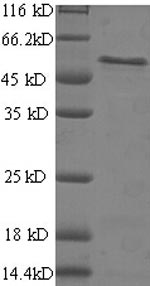Amino acids 2-243 form the expressed segment for recombinant Human BCAP31. The theoretical molecular weight of the BCAP31 protein is 54.5 kDa. Expression of this BCAP31 protein is conducted in e.coli. The N-terminal GST tag was fused into the coding gene segment of BCAP31, making it easier to detect and purify the BCAP31 recombinant protein in the later stages of expression and purification.
The human B-cell receptor-associated protein 31 (BCAP31) is a crucial component associated with the endoplasmic reticulum (ER) membrane. BCAP31 participates in diverse cellular processes, including protein trafficking, apoptosis, and ER homeostasis. BCAP31 is involved in the quality control of ER-derived vesicles and facilitates the transport of proteins from the ER to the Golgi apparatus. Research on BCAP31 explores its multifaceted functions, shedding light on its roles in cellular pathways and potential implications in diseases related to ER dysfunction. Understanding BCAP31 provides insights into cellular organization, and vesicle trafficking, and may offer therapeutic targets for conditions associated with ER stress.






